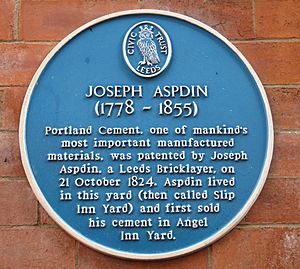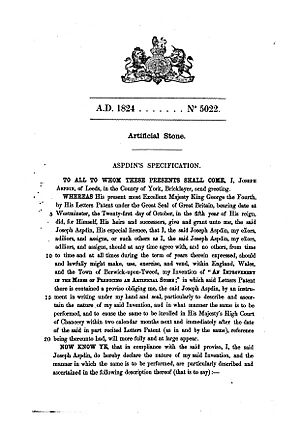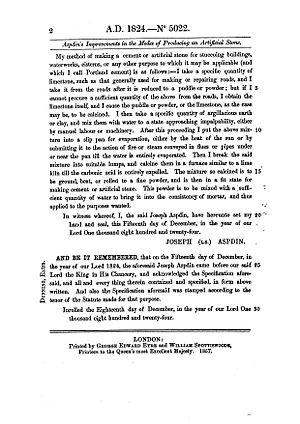Joseph Aspdin facts for kids
Quick facts for kids
Joseph Aspdin
|
|
|---|---|
| Born | 25 December 1778 |
| Died | 20 March 1855 (aged 76) |
| Occupation | Bricklayer, businessman, inventor, stonemason |
Joseph Aspdin (born December 25, 1778 – died March 20, 1855) was an English bricklayer, businessman, and inventor. He is famous for getting the patent for Portland cement on October 21, 1824. This invention changed how buildings were made.
Contents
Life of an Inventor
Joseph Aspdin was the oldest of six children. His father, Thomas Aspdin, was also a bricklayer in Hunslet, Leeds, England. Joseph was born on Christmas Day in 1778. He followed in his father's footsteps and became a bricklayer. In 1811, he married Mary Fotherby.
By 1817, Joseph had started his own business in Leeds. He spent the next few years experimenting with making cement. On October 21, 1824, he received a special document called a British Patent. This patent was for "An Improvement in the Mode of Producing an Artificial Stone." In this document, he used the name "Portland cement" for the first time. He chose this name because his new cement looked like Portland stone. This was a popular building stone from the Isle of Portland in England.
Soon after getting his patent, in 1825, Joseph teamed up with William Beverley. They opened a factory in Wakefield to make Portland cement. Joseph and his family moved to Wakefield, which was about nine miles away. In 1825, he also got another patent for a way to make lime.
The first factory in Kirkgate, Wakefield, had to close in 1838. This happened because the land was needed for the Manchester and Leeds Railway Company. Joseph then moved his equipment to another nearby location.
Joseph's oldest son, James, worked as an accountant. His younger son, William, was helping run the cement factory. In 1841, Joseph partnered with James. He announced that William was no longer working for him.
In 1843, William started his own cement factory near London. He created a new and much stronger cement. This was made using a different recipe. Many people consider this the first "modern" Portland cement. In 1844, Joseph retired. He gave his share of the business to James. James moved the factory to a third site in 1848. This factory kept making cement until 1900. Joseph Aspdin passed away at his home in Wakefield on March 20, 1855.
The Patent for Portland Cement
A patent is a special legal document. It gives an inventor the right to be the only one to make, use, and sell their invention for a certain time. Joseph Aspdin's patent was for his new way of making "artificial stone," which he called Portland cement.
In his patent, Joseph described his method. He would take a certain amount of limestone. He often got this from roads after it had been crushed into a powder. If he couldn't find enough road powder, he would use limestone rock itself. He would then heat this limestone in a kiln.
Next, he would take a specific amount of clay. He would mix the clay and the heated limestone with water until it was very smooth. This mixture would then be dried. After drying, he would break the mixture into lumps. These lumps were heated again in a furnace, similar to a lime kiln. This process removed all the carbon dioxide.
Finally, the heated mixture was ground into a fine powder. This powder was then ready to be mixed with water. When mixed, it became like mortar and could be used to make cement or artificial stone.
Why Portland Cement Was Important
Joseph Aspdin named his product "Portland cement" because it looked like the famous Portland stone. This stone was a very popular and fancy building material in England at the time. Joseph's cement was designed to be used for things like stucco (a type of plaster for walls) and decorative stone shapes. For these uses, a cement that set quickly and was not super strong was needed.
The way Joseph made his cement was a "double burning" process. This meant the limestone was heated first, then mixed with clay, and heated again. This was common when only hard limestones were available. It was easier to break down the hard limestone by heating it than by grinding it.
Joseph used limestone from the Pennines area. This limestone was also used for paving roads. Interestingly, Joseph sometimes used "road sweepings" as a raw material for his cement. He said if he couldn't get enough sweepings, he would use the limestone itself.
Joseph's son, William Aspdin, later made an important improvement. He used more limestone in his mix and heated it to a much higher temperature. This created a harder material called "clinker." William then ground this clinker into a fine powder. This made a stronger cement. William did not get a new patent for his improved process. In 1848, William moved to Kent, where there was a lot of soft chalk. This chalk was much easier to use for making cement. William Aspdin is often given credit for starting the "modern" Portland cement industry.
See also
 In Spanish: Joseph Aspdin para niños
In Spanish: Joseph Aspdin para niños




